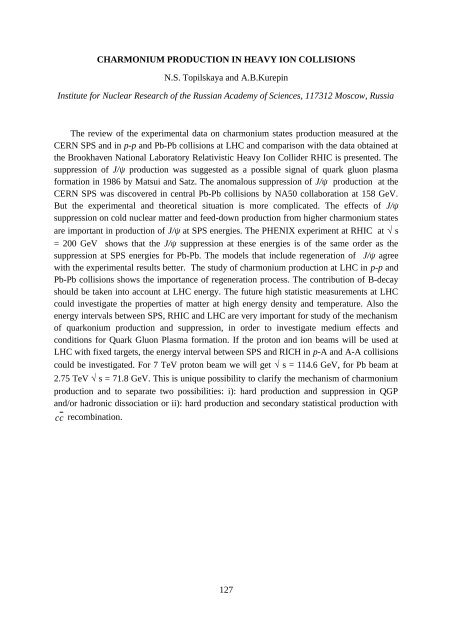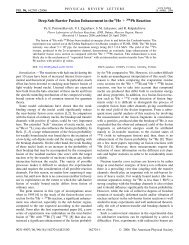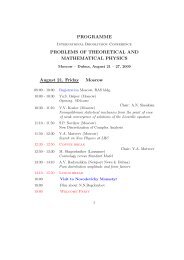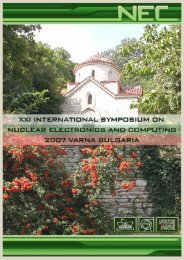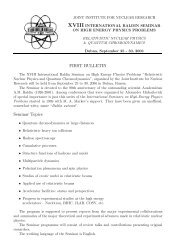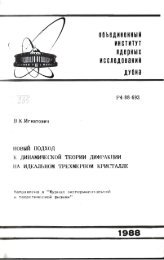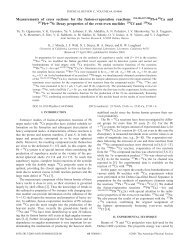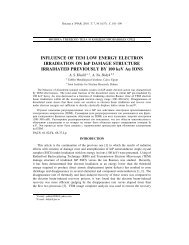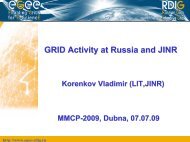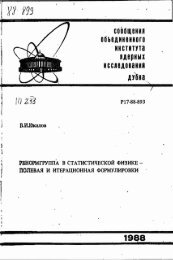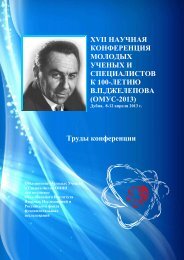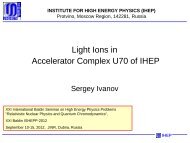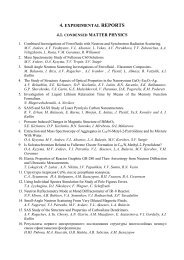Joint Institute for Nuclear Research Relativistic ... - Index of - JINR
Joint Institute for Nuclear Research Relativistic ... - Index of - JINR
Joint Institute for Nuclear Research Relativistic ... - Index of - JINR
Create successful ePaper yourself
Turn your PDF publications into a flip-book with our unique Google optimized e-Paper software.
CHARMONIUM PRODUCTION IN HEAVY ION COLLISIONS<br />
N.S. Topilskaya and A.B.Kurepin<br />
<strong>Institute</strong> <strong>for</strong> <strong>Nuclear</strong> <strong>Research</strong> <strong>of</strong> the Russian Academy <strong>of</strong> Sciences, 117312 Moscow, Russia<br />
The review <strong>of</strong> the experimental data on charmonium states production measured at the<br />
CERN SPS and in p-p and Pb-Pb collisions at LHC and comparison with the data obtained at<br />
the Brookhaven National Laboratory <strong>Relativistic</strong> Heavy Ion Collider RHIC is presented. The<br />
suppression <strong>of</strong> J/ψ production was suggested as a possible signal <strong>of</strong> quark gluon plasma<br />
<strong>for</strong>mation in 1986 by Matsui and Satz. The anomalous suppression <strong>of</strong> J/ψ production at the<br />
CERN SPS was discovered in central Pb-Pb collisions by NA50 collaboration at 158 GeV.<br />
But the experimental and theoretical situation is more complicated. The effects <strong>of</strong> J/ψ<br />
suppression on cold nuclear matter and feed-down production from higher charmonium states<br />
are important in production <strong>of</strong> J/ψ at SPS energies. The PHENIX experiment at RHIC at √ s<br />
= 200 GeV shows that the J/ψ suppression at these energies is <strong>of</strong> the same order as the<br />
suppression at SPS energies <strong>for</strong> Pb-Pb. The models that include regeneration <strong>of</strong> J/ψ agree<br />
with the experimental results better. The study <strong>of</strong> charmonium production at LHC in p-p and<br />
Pb-Pb collisions shows the importance <strong>of</strong> regeneration process. The contribution <strong>of</strong> B-decay<br />
should be taken into account at LHC energy. The future high statistic measurements at LHC<br />
could investigate the properties <strong>of</strong> matter at high energy density and temperature. Also the<br />
energy intervals between SPS, RHIC and LHC are very important <strong>for</strong> study <strong>of</strong> the mechanism<br />
<strong>of</strong> quarkonium production and suppression, in order to investigate medium effects and<br />
conditions <strong>for</strong> Quark Gluon Plasma <strong>for</strong>mation. If the proton and ion beams will be used at<br />
LHC with fixed targets, the energy interval between SPS and RICH in p-A and A-A collisions<br />
could be investigated. For 7 TeV proton beam we will get √ s = 114.6 GeV, <strong>for</strong> Pb beam at<br />
2.75 TeV √ s = 71.8 GeV. This is unique possibility to clarify the mechanism <strong>of</strong> charmonium<br />
production and to separate two possibilities: i): hard production and suppression in QGP<br />
and/or hadronic dissociation or ii): hard production and secondary statistical production with<br />
c c recombination.<br />
127


